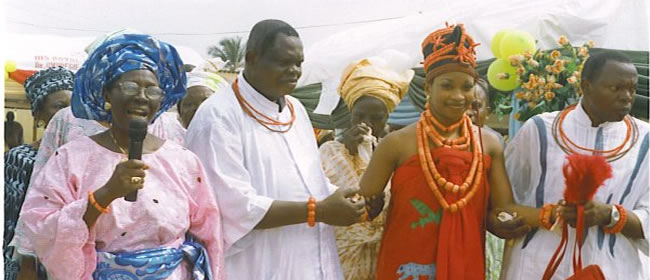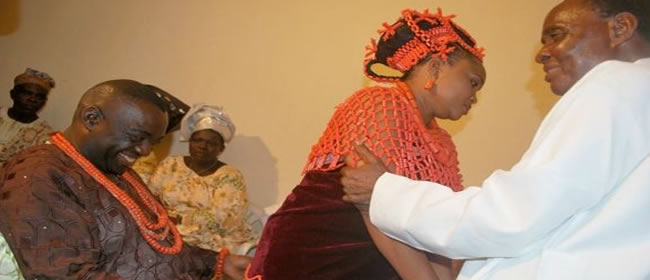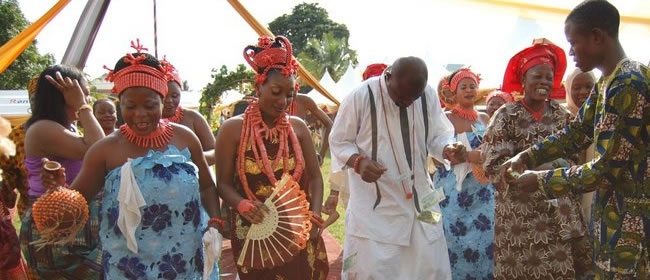The Bini are basically a polygamous group. Polygyny involving grown-ups is predominant. The Bini hold tenaciously to this pattern of marriage because it was so practiced by their great Ancestors. An average Bini man who marries as an adult commands great respect. He is held in high esteem by the people in the Community.
The people embrace polygyny as a way of life for several reasons. These include the need for a man to have many women to assist him in his domestic and economic (mainly farming) activities and the economic and social benefits derived from having many children. Men also strive to have children from different women because of the belief that when a man gets all his children from a woman, he has only one “door” as opposed to the one who has five children from five different women. The latter is regarded as, having many “doors” and is therefore regarded as an “Odafen” in the society.

The Bride coming to the place of the marriage
The people also believe that the number of children a man has also guarantees the protection of members of his family from any form of aggression especially in the past when intra-ethnic wars were a common phenomenon. Added to this, is the need of the average Bini-man to have a fitting burial after his death. It is felt that the presence of many children would add some glamour to the burial occasion. This explains why some families take delight in calling for many “Oton” to be featured by the children of the deceased during the outing-ceremony or procession along the major streets in the Community.
Finally, besides the fact that having many children is a symbol of a man’s wealth in his community, it is also one determining factor for the conferment of chieftaincy titles either by the Oba of Benin or the Enogie of a given community. A man who has a single wife, it is assumed, is not likely to be able to cope with all the responsibilities associated with the office of a chief especially during festival occasions.
Choice of Partners: Generally, the choice of a partner rests either on the man or his parents. In most cases, the man makes his choice, which may be supported by his parents depending on how well the girl and her family are known. Parents can disapprove of their son’s choice if they discover that the girl is not from an acceptable or reputable family.
The Negotiation Process: This is an interesting phenomenon in the adult marriage. Negotiation takes several steps. In the first instance, it is done through the Odibo who is familiar with members of both families concerned. This man prepares a fertile ground for’ further negotiations. He carries words from the girl’s father to the suitor’s father and vice versa. He is the man at the helm of affairs during the marriage ceremonies. He also acts as an arbiter in any case of dispute.
At the later stages of the negotiation, both families become livelier. The suitor’s parents, together with other relations and the middle man (the Osuomwan), now go to the house of the girl’s father to negotiate for his daughter’s hand in marriage. This meeting takes place in the evening.
The girl’s father pretends not to know the object of the people’s mission but presents them with kola-nuts and a bottle of hot gin or a keg of palm-wine, depending on what he can afford. At this stage, the suitor’s father discloses the object of his mission before the breaking of the kola-nuts and the drinking of the wine. This is done because of the belief that only a foolish man would drink before disclosing the object of his mission at his would-be in-law’s house.
As soon as the purpose of the visit is disclosed, the suitor’s father presents a keg of palm-wine, a bottle of hot gin and four kola-nuts through the middleman to the would-be father-in-law who then asks to know which of his daughters hand is being sought in marriage. This is announced. Thereafter, the kola-nuts are broken in the traditional way by the eldest man in the gathering. In some areas, the acceptance of the kola-nuts and the drinks by the girl’s father is an indicator of his likely acceptance of the suitor.
After this formal negotiation, the relationship between both families grows mare cordial. The suitor’s parents visit their in-laws frequently and also begin to regard themselves as Orhuaen.
Courtship: The duration of courtship is fairly long and this affords the would-be-couple ample opportunity to study themselves and get used to each other. During this period, the suitor also visits his fiancée regularly. The would-be-bride also pays occaional visits to the suitor’s mother and relations. These familiarization visits are to enable her mother-in-law and others in the family study her character closely and get used to her. The couples are forbidden from having sexual intercourse during the period of courtship. It is however common for such an act to be carried out in secret.
The suitor and his father render some service to their in-laws annually during this period. Also, the girl’s parents receive gifts such as the leg of an antelope, palm-wine and kola-nuts during annual festivals of “Igue” and “Eho”. The girl’s mother is also given some yams and a portion of cleared land by her in-laws to farm. The ability of the suitor to adhere to these norms helps to strengthen the existing relationship between both families.
Identification Parade: One of the very exciting events during the marriage ceremony is the identification parade organized to identify the would-be-bride. This ceremony is used to test the ability of the suitor or his father to identify the lady he wants to marry. As is the practice, members of the girl’s family arrange a parade of all the girls in the household. They appear in disguise and emerge one after the other in colourful dresses. The suitor or his father is free to identify the girl whose hand is being sought in marriage. In most cases, the would-be-bride is brought out last. As soon as the Bride is identified, her father demands to know from her whether she intends to marry the suitor. On receiving a positive response from her, the same question is put to the suitor who also responds in the affirmative.
When the questioning is over, the would-be-bride’s family fixes the bride-price. The value of the bride-price varies from one family to another. Before the advent of modern currency, the payment of bride-price was done in the form of cowries (Ikpigho) amount ranges from forty to sixty (40 to 60) cowries which are shared between the paternal and maternal members of the girl family.
When modern currency was eventually introduced as a means of buying and selling, the bride-price was fixed at the standard sum of £12.00 or N24.00. This amount is given to the girl’s father. In addition to this, the sum of five pounds (5.0O) or ten naira (N10.00) is given to the mother while the bride herself gets three pounds (3.OO) or six naira (N6.00). The sum of three pounds, three shillings (i3.3s) or six naira sixty kobo (N6.60) is also given to the girl’s male and female relations known as “Ibieguae” in consummation of the marriage.
Some people share the view that marriage has become commercialized in some communities. Bride-pride in such Communities can range from sixty to one hundred naira (N60.00 — N100.00). In addition, the suitor gives twenty naira (N20.00) each, to the girl and her mother and ten naira, (N1O.00) to her female and male relations known as “Ibieguae ‘The position today is that some affluent families do not even accept bride-price from their in-laws. They observe all the necessary ceremonies associated with the marriage and insist on adequate maintenance of their daughter by the Bride-groom.
On this occasion, the suitor pays the sum of twenty-five kobo (25k) as betrothal fee in addition to a presentation of twenty kola nuts, native chalk (“Osorhue”), a keg of palm-wine and a bottle o native gin — “Ogo-uru” to solemnize the marriage in the presence of members of both families. During this presentation, the suitor kneels down and is called by his name seven times by one of his Bride’s relations. When he hears his name the seventh time, he responds with the word “Eyo “The Bride’s father later declares that hence forth his daughter is given to the suitor as a wife. Thereafter, the Bride—groom resumes his seat. The girl is made to sit on the groom’s father’s laps because he is symbolically regarded as the husband of the bride. The Bride’s father later goes to his ancestral shrine with his daughter, her husband and selected members of both families to pray to the ancestors to bless the couple and make their marriage fruitful. For this ceremony, the groom offers four kola-nuts, a bottle of native gin and forty kobo (40k). This used to be four cowries in the past.
The couple becomes bonfire husband and wife after this ceremony. A date is later fixed for the Bride to move to her matrimonial home. It is worthy of note that in the past, the inscription of tribal marks on male and female adults used to take place before wedding, this exercise was regarded as an initiation of the Bride and the Bride groom into adulthood. Today, the ceremony is rarely practiced due to modernization.

The Bride is place on the groom’s father’s laps
Departure of the Bride for the Husband’s House:
The first day of a traditional wedding is full of exciting events. A market day is earmarked for delivering the Bride to her husband. A market day is regarded as a blessed day for a wedding. On the evening of the accepted day, the Bride’s relations and well-wishers gather in her father’s house to prepare her for the journey to her husband’s house. She is advised to be of good behaviour when she gets to her matrimonial home since respect for her family would depend on that.
The Bridegroom, in preparation for his wife’s arrival, decorates his house and makes other preparations in readiness to receive her in a very grand manner. He equally informs his relations and well-wishers of his father-in-laws’s intention to honour his promise of sending his Bride to him on the agreed day. Consequently, the Bridegrooms relations, friends and well-wishers assemble in his house to welcome the Bride to her matrimonial home
The Bride arrives in her husband’s house in a colourful procession. Some female members of her family help to carry her dowry of clothes, gold ornaments, brooms, goats, etc. along sometime. Besides, a grown-up female relation of hers is made to stay with her for seven days to study the events in her matrimonial home and report to her parents. In addition, she helps to educate the Bride on what to do with regard to marital affairs.
As the Bride’s procession moves along the street, the women sing praises of her and her family. Occasionally, the procession is unable to continue due to an imaginary barriers of wood (ughughun) lying across the road. The Bridegroom cuts the barrier of wood symbolically by paying some amount of money in addition to four kola-nuts all of which are usually given to her escorts. The Bridegroom Usually goes through this symbolic removal of the barrier from the road three times before the entry of the Bride and her entourage into her husband’s house.

The Bride and the Bridegroom are dancing after indoor marriage process
As soon as the Bride and her entourage enter her husband’s house, they are welcome with four kola-nuts, forty kobo (40k) (forty cowries in the past), a keg of palm-wine and a bottle of native gin. These items are received by the eldest man in the Bride’s entourage. He also places the Bride on her husband’s or his father’s laps and says they have brought his wife to him in good faith. The Bridegroom’s relations, friends and well-wishers follow up by presenting gifts to the Brides entourage. As the merry-making continue, the Bride’s entourage departs with a goodwill message from the groom to his in-laws. He also sends nine (9) kola-nuts and sixty-six (66k) kobo (sixty-six cowries in the past) through the leader of the Bride’s entourage to her father at home.
The second day of the celebration sees the Bridegroom receiving and entertaining his visitors and well-wishers. The Bride stays in her room with friends and elderly women who come to greet and acvise her about the complexity of matrimony. Members of the entourage who followed her to her husband’s house on the first day also come to visit her and to see how far she is adjusting to her new life. They are entertained with pounded yam, drinks, and kola-nuts and twenty (20k) kobo (twenty cowries in the past).
On the third day, the Bridegroom with his relations and friends go to his father-in-law’s house to thank him for the honour done him. The couple are also, by tradition, expected to make love for the first time on the third day. The Bridegroom carried out an elaborate preparation to suit this purpose. His bed is gorgeously made with white bed-spread. This is to test the girl’s virginity where this is confirmed, the Bride is highly acclaimed. The bride is said to have been met at home by her husband — Odo ore vbaa ore vbe owa. If opposite is the case, the bride is made to confess before her husband’s family all those that have “talked” to her as well as made love to her. If she feels ashamed to name them, if more than one, she throws up some grains of sand which indicates that the number of the persons is much and this is at once understood by everybody present there. In the case whereby she was engaged in a love affair intentionally or unintentionally with her relation, say cousin, a goat is killed and both ‘offenders’ are given an ear of the goat to share and eat while a cudgel is used by an elder to flog them for committing such an offence. Again, if it is somebody that is not related to her, she is forbidden to greet and talk to him all the rest of her life and in the case of somebody she cannot avoid greeting, a kolanut is given to that man to wipe off that taboo. This process of purification is also applicable to a returnee divorcee.
After the bride has finally ‘settled her waist’ in her matrimonial home she is woken up one early morning by her husband and taken to his ancestral shrine (Aro-Erha). Before her are kolanuts and wine and she is subjected to an oath whereby she is made to swear in this manner:
“Now I am married to Efehi and if in any way I plan evil against him and his people, may it boomerang. Or because I have sworn, I decide to employ somebody to carry out the plan for me, may it also boomerang"
She cuts from a piece of the kolanut, chews it and then sips from the wine.
The fourth and the fifth days of the wedding ceremonies are usually set aside for entertaining visitors from both families. On the fifth day, the bride’s father is obliged to send pounded yam and delicious soup cooked with antelope’s legs to his daughter in her husband’s house early in the morning. According to tradition the Bridegroom is expected to demonstrate his appreciation for the kind gesture by presenting gift of forty (40k) kobo (forty cowries in the past), four (4) kola-nuts, and palm-wine to those who brought the food. Later, on the same day, the Bride’s father and some of his relations and well-wishers arrive at his in-law’s house on a visit and to see to the welfare of his daughter. The Bridegroom welcomes his in-law and others in his entourage with four (4) kola-nuts and palm-wine. The occasion is one of joy and merry-making. The visitors advised the couple before parting with the gifts given to them by the Bridegroom, his relations, and friends.
The seventh day of the wedding ceremony also records several interesting events. On this day, the Bridegroom prepares pounded yam and delicious soup with antelope meat for his mother-in-.law and her relations who usually visit. They are treated to a rousing reception as soon as they enter the Bridegroom’s house. But before she accepts anything from her in-law, she holds some consultations with her daughter on her general welfare and the sexual capability of her husband. The reason behind this is that no mother would want her daughter to be married to an impotent man no matter his social status. This is also an occasion to announce to the Bride’s mother the discovery regarding her daughter’s virginity. She is also presented with the white cloth they used on their nuptial night. Thereafter, she is presented with several gifts by the Bridegroom and his relations for the good up-bringing of her daughter. This is followed with jubilation merry-making. The Bride’s mother and her entourage return home later in the day with several gifts given to them and with message of .goodwill to the Bride’s father.